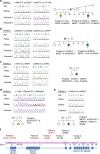Mutations in NLRP5 are associated with reproductive wastage and multilocus imprinting disorders in humans
- PMID: 26323243
- PMCID: PMC4568303
- DOI: 10.1038/ncomms9086
Mutations in NLRP5 are associated with reproductive wastage and multilocus imprinting disorders in humans
Abstract
Human-imprinting disorders are congenital disorders of growth, development and metabolism, associated with disturbance of parent of origin-specific DNA methylation at imprinted loci across the genome. Some imprinting disorders have higher than expected prevalence of monozygotic twinning, of assisted reproductive technology among parents, and of disturbance of multiple imprinted loci, for which few causative trans-acting mutations have been found. Here we report mutations in NLRP5 in five mothers of individuals affected by multilocus imprinting disturbance. Maternal-effect mutations of other human NLRP genes, NLRP7 and NLRP2, cause familial biparental hydatidiform mole and multilocus imprinting disturbance, respectively. Offspring of mothers with NLRP5 mutations have heterogenous clinical and epigenetic features, but cases include a discordant monozygotic twin pair, individuals with idiopathic developmental delay and autism, and families affected by infertility and reproductive wastage. NLRP5 mutations suggest connections between maternal reproductive fitness, early zygotic development and genomic imprinting.
Figures

References
-
- Peters J. The role of genomic imprinting in biology and disease: an expanding view. Nat. Rev. Genet. 15, 517–530 (2014). - PubMed
-
- Mackay D. J. et al.. Hypomethylation of multiple imprinted loci in individuals with transient neonatal diabetes is associated with mutations in ZFP57. Nat. Genet. 40, 949–951 (2008). - PubMed
-
- El-Maarri O. et al.. Maternal alleles acquiring paternal methylation patterns in biparental complete hydatidiform moles. Hum. Mol. Genet. 12, 1405–1413 (2003). - PubMed
Publication types
MeSH terms
Substances
Supplementary concepts
Grants and funding
LinkOut - more resources
Full Text Sources
Other Literature Sources
Medical
Molecular Biology Databases

